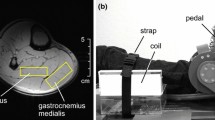Abstract
We investigated whether localized 1H nuclear magnetic resonance spectroscopy (NMRS) using stimulated echoes (STEAM) with a long mixing time (t m) allowed the suppression of the fat signal and detection of lactate in skeletal muscle. The 1H NMRS sequence was first validated in three isolated and perfused rabbit biceps brachii muscles. Spectra were obtained on a wide-bore spectrometer using a dual-tuned probe (1H and 31P). Death was simulated by ceasing the muscle perfusion, which allowed post-mortem changes to be followed. During and after the simulated death, changes in levels of pH and in content of energy-rich compounds were observed with 31P NMRS. Our results showed an inverse linear relationship between pH and lactate in each of the three rabbits (r = 0.93, P < 0.001; r = 0.92, P < 0.01; r = 0.89, P < 0.01) and a decrease in phosphocreatine and concomitant increase in lactate. We then investigated whether this sequence allowed repeated detection of lactate in human soleus muscle during the recovery between periods of intense exercise (force-velocity test, F-v test). Seven subjects mean age 25.1 (SEM 0.8) years participated in this study. Soleus muscle lactate was detected at rest and for 3 min 30 s of the 5-min recovery between periods using a 2.35-T 40-cm bore magnet spectrometer. Arm venous plasma lactate concentration was measured at rest, during the F-v test when the subject stopped pedalling (S1), and at the end of each 5-min recovery between periods (S2). Results showed that the venous plasma lactate concentration at S1 and S2 increased significantly from the beginning of the F-v test to peak anaerobic power (W an,peak) (P < 0.001). The spectra showed that muscle lactate resonance intensity rose markedly when W an,peak was achieved. The muscle lactate resonance intensity plotted as a percentage of the resting value increased significantly at W an,peak compared with submaximal braking forces (P < 0.05). We concluded from these results that localized 1H NMRS using STEAM with a long t m allows suppression of the fat signal and repeated detection of lactate on isolated perfused skeletal muscle in animals and between periods of intense exercise in humans.
Similar content being viewed by others
Author information
Authors and Affiliations
Additional information
Accepted: 19 January 1998
Rights and permissions
About this article
Cite this article
Mercier, B., Granier, P., Mercier, J. et al. Noninvasive skeletal muscle lactate detection between periods of intense exercise in humans. Eur J Appl Physiol 78, 20–27 (1998). https://doi.org/10.1007/s004210050382
Issue Date:
DOI: https://doi.org/10.1007/s004210050382




